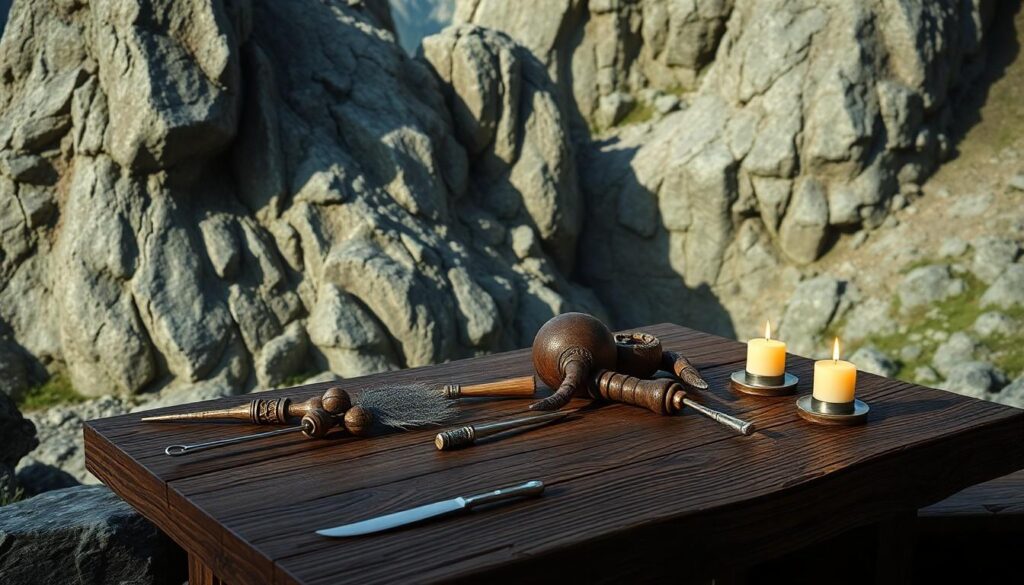Looking for the perfect dwarf name that captures strength, resilience, and a touch of fantasy? We’ve compiled an extensive collection of dwarf names that’ll inspire your character creation, whether for role-playing games, fantasy writing, or naming your next D&D hero.
Dwarf names typically reflect their culture’s appreciation for craftsmanship, mining heritage, and warrior spirit. From classic Norse-inspired options like Thorin and Balin to unique modern creations, our guide covers male and female dwarf names across different fantasy traditions. We’ll help you understand the naming conventions that make dwarf nomenclature so distinctive and memorable.
The Rich History Behind Dwarf Names in Mythology and Fantasy
Dwarf names have evolved from ancient Norse mythology, where these beings were known as “dvergr” and were primarily associated with craftsmanship and mining. Their naming traditions date back to the Poetic Edda, particularly in the poem Völuspá, which lists dozens of dwarf names like Durin, Dvalin, and Bombur. These original Norse dwarf names typically reflected their skills, physical characteristics, or personalities, establishing a pattern that continues in modern fantasy.
J.R.R. Tolkien significantly transformed dwarf naming conventions in his Middle-earth works, creating a comprehensive linguistic system for his dwarves. Tolkien borrowed heavily from Norse mythology but added layers of complexity, introducing “public” names used among other races and secret true names in Khuzdul (the dwarf language) known only to other dwarves. Names like Thorin Oakenshield, Balin, and Gimli have become archetypes for modern fantasy dwarf naming.
Fantasy roleplaying games, particularly Dungeons & Dragons, further expanded dwarf naming traditions beginning in the 1970s. D&D established distinct clan names and personal names, often featuring hard consonants and short, powerful syllables. The game’s various settings created multiple dwarf subraces, each with unique naming conventions reflecting their particular cultural characteristics and environments.
Industry of Warcraft revolutionized dwarf representation in popular culture, introducing millions to names like Magni Bronzebeard and Muradin. WoW dwarves typically have Scottish-inspired surnames and shorter first names, often featuring strong consonants. This distinctive naming style has influenced countless other fantasy games and literature, cementing the association between dwarven culture and Celtic/Norse naming patterns.
Modern fantasy literature and games have diversified dwarf naming beyond Norse influences, incorporating elements from Celtic, Germanic, Slavic, and even Middle Eastern naming traditions. Authors like Terry Pratchett and games like Dragon Age have introduced female dwarf characters with distinctive naming conventions, addressing the historical underrepresentation of female dwarves in earlier works. This expansion has created a rich tapestry of naming options that game masters, writers, and players can draw from when creating dwarf characters.
10 Most Popular Dwarf Names in Fantasy Literature

- Balin stands as one of the most recognizable dwarf names from J.R.R. Tolkien’s “The Hobbit” and “The Lord of the Rings,” known for his wisdom and diplomacy among the dwarven characters.
- Gloin, father of the famous Gimli, appears prominently in Tolkien’s works and has become a staple name in fantasy literature for dwarven characters with strong family lineages.
- Dain has earned important popularity as a dwarf name following his important role in “The Hobbit” and “The Lord of the Rings,” where he demonstrated exceptional leadership qualities.
- Durin, considered the founder of the Longbeard dwarves in Tolkien’s legendarium, represents one of the most revered names in dwarf naming traditions across fantasy worlds.
- Thrain, father of Thorin Oakenshield in “The Hobbit,” has influenced countless dwarf name selections in role-playing games and fantasy fiction due to its strong, traditional sound.
- Thorin Oakenshield remains perhaps the most famous dwarf name in all of fantasy literature, with his leadership of the company in “The Hobbit” cementing his legacy.
- Gimli achieved widespread recognition through his membership in the Fellowship of the Ring, making this name instantly recognizable to fantasy fans worldwide.
- Fimbul, while less common than some Tolkien-inspired names, appears in various fantasy works and draws from authentic Norse mythology roots.
- Keldin finds popularity in multiple fantasy sources, particularly in works that follow Tolkien’s naming conventions while creating distinctive character identities.
- Dvalin, originating from Norse mythology, has transitioned successfully into fantasy literature as authors seek authentic-sounding dwarf names with historical significance.
Tolkien’s Influential Dwarf Naming Conventions
J.R.R. Tolkien revolutionized dwarf naming conventions in fantasy literature through his meticulous approach to language and mythology. His dwarf names draw heavily from Norse and Germanic roots, with characters like Durin, Dvalin, and Thorin reflecting these ancient linguistic influences. Tolkien established the common practice of patronymic surnames in dwarf culture, seen in examples like “Gloin son of Gróin” and “Thorin Oakenshield son of Thráin,” which countless fantasy authors have since adopted.
The meaningful nature of Tolkien’s dwarf names also set a precedent for fantasy literature. Names were carefully selected for their connotations and historical significance, such as “Durin,” which means “sleepy” or “drowsy” in Old English, reflecting the mythological figure’s legendary long slumber. This attention to linguistic detail and cultural consistency created a blueprint that modern fantasy authors continue to follow when crafting authentic dwarf characters and societies.
Names from The Hobbit That Endure Today
Several dwarf names from “The Hobbit” have achieved iconic status in fantasy literature and continue influencing character naming across media. Balin, known for his search to reclaim Erebor and later lordship of Moria, remains one of the most frequently referenced dwarf names in modern fantasy works. Gloin, whose legacy extended through his son Gimli in “The Lord of the Rings,” exemplifies the multigenerational approach to dwarf character development now common in fantasy.
Thorin Oakenshield’s name has become virtually synonymous with dwarf leadership and nobility, establishing a naming pattern for royal or aristocratic dwarves across the genre. Dwalin, celebrated for his axe-wielding prowess, set the standard for warrior dwarf naming conventions that countless games and novels have adopted. The younger dwarves Fili and Kili introduced a different naming style for youthful characters, showing how even within one work, Tolkien created naming patterns that reflected different generations and personality types. These names continue inspiring authors, game designers, and fantasy enthusiasts seeking authentic dwarf character names with literary significance.
How to Create Authentic-Sounding Dwarf Names for Role-Playing Games

Creating compelling dwarf names requires understanding both their phonetic structure and cultural significance. We’ve compiled essential guidelines to help you create names that resonate with authenticity and depth for your role-playing adventures.
Essential Phonetic Elements of Dwarf Names
Consonant clustering forms the backbone of distinctive dwarf names, with combinations like those found in “Kragnir” or “Thrain” creating that instantly recognizable dwarven sound. Strong, guttural sounds including ‘k’, ‘g’, ‘th’, and ‘r’ give dwarf names their characteristic rugged feel, exemplified in names like “Gloin Girdlegrip” and “Hagar Hammerfist.” Exact suffixes such as “-dan,” “-dran,” and “-gran” appear frequently in traditional dwarf naming patterns, while prefixes like “Iron,” “Bronze,” and “Hammer” immediately establish a character’s dwarven heritage. The name structure typically follows a pattern of either a first name with a descriptive surname or a name followed by an epithet that highlights achievements, such as “Kragnir the Unyielding.”
Cultural Considerations When Crafting Dwarf Names
Heritage and clan affiliations significantly influence dwarf naming conventions, with names like “Reorx Brurgrock” suggesting exact family lineages or clan connections. Occupational references often appear in surnames, reflecting the dwarven culture’s emphasis on craftsmanship and skill, as seen in names like “Boldo Boulderbelly” or “Flinty Flatfoot.” Linguistic influences from Old English, Norse, and Germanic languages add authenticity to dwarf names, with examples like “Thrain Thunderpants” carrying distinct Norse-inspired phonetics. Honorary titles frequently complement base names, acknowledging important achievements or personality traits within dwarven society, such as “Grom Brekin” or “Iron Anvilbeard.” Game setting also matters when creating dwarf names, as names appropriate for the grim setting of Warhammer Fantasy might differ substantially from those suited to a more lighthearted campaign.
Female Dwarf Names and Their Distinctive Characteristics

Female dwarf names blend strength and elegance while carrying deep cultural significance. These names often feature softer tones and more melodic sounds than their male counterparts, creating a beautiful contrast within dwarven naming traditions.
Female dwarf names typically exhibit several distinctive characteristics:
- Melodic Quality: Names like Ailiel, Aithina, and Arinna showcase the softer, more musical nature of female dwarf nomenclature.
- Professional Associations: Many names reflect exact skills or occupations within dwarven society. Adelina suggests a skilled blacksmith, while Bargina indicates someone renowned for forging weapons and armor. Hilda represents a master stonemason, and Karissa denotes an expert jeweler.
- Earth Connections: Female dwarf names often incorporate references to gemstones, minerals, and natural elements, honoring the dwarven connection to the earth.
- Cultural Influences: Names draw from diverse linguistic roots, including Norse (Ábria, Alda, Alrún), Anglo-Saxon, and Celtic traditions (Andraste, Genevieve).
Breaking Stereotypes with Modern Female Dwarf Names
Modern female dwarf naming conventions challenge traditional stereotypes by embracing both strength and elegance. These contemporary names offer greater diversity while maintaining authentic dwarven characteristics.
Recent naming trends include:
- Diverse Meanings: Modern names span various associations from combat prowess to mercantile skills. Amara represents a fearless warrior, while Jorunna indicates a shrewd trader with business acumen.
- Creative Innovations: Unique names that preserve dwarven cultural elements while introducing fresh sounds and combinations have gained popularity. Aithina, known for concocting powerful potions and elixirs, exemplifies this creative approach. Katnora offers an elegant option for roleplaying games like Dungeons & Dragons.
- Balanced Attributes: Contemporary female dwarf names often balance traditionally masculine qualities of strength and resilience with feminine elements like creativity and wisdom.
Historical Roots of Female Dwarf Naming Traditions
The historical foundations of female dwarf naming conventions reflect rich cultural exchanges and linguistic influences over centuries.
Key historical influences include:
- Norse Mythology: Many female dwarf names derive directly from Norse roots, reflecting the strong connection between Norse traditions and dwarven lore. Names like Ábria, Alda, and Alrún demonstrate this Norse heritage.
- Celtic and Anglo-Saxon Elements: Female dwarf names frequently incorporate Irish, Scottish, and Anglo-Saxon linguistic patterns. Andraste and Genevieve showcase these Celtic influences within dwarven naming traditions.
- Family and Clan Significance: Surnames often indicate familial crafting traditions or clan affiliations. The surname Ironfist, for example, typically belongs to a dwarf from a renowned family of blacksmiths.
- Cultural Preservation: Throughout fantasy literature, female dwarf names have maintained connections to ancient linguistic roots while evolving to reflect changing cultural perceptions and gender roles within dwarven societies.
Norse-Inspired Dwarf Names and Their Meanings

Norse mythology provides us with a treasure trove of authentic dwarf names that carry powerful meanings and rich history. Many fantasy creators draw from these ancient sources when crafting compelling dwarf characters.
Ancient Norse Mythology’s Influence on Dwarf Naming
Norse mythology features many dwarves with names that reflect their characteristics or abilities. Alvíss, meaning “all wise,” was renowned for his exceptional intelligence and almost married Thor’s daughter Thrud before Thor cleverly tricked him by asking questions until sunrise, turning him to stone. Ginnar translates to “the deceiver” and appears in both the Vǫluspá poem and Snorri’s Þulur, sharing an alternative title with Odin himself. Glóinn (or Glóin) means “the glowing one” and is mentioned in the 15th stanza of Vǫluspá, later becoming a important character in Tolkien’s works. Hánnar represents “the skillful one” and appears in ancient Norse texts alongside Haugspori, whose name likely means “the one who treads hills.” Oin, father of Andvari, has influenced countless fictional dwarf characters across modern fantasy. Durin, while not directly from Norse mythology, derives from Old Norse roots meaning “sleepy” and has become one of the most iconic dwarf names in fantasy literature.
Modern Adaptations of Norse Dwarf Names
J.R.R. Tolkien drew extensively from Norse mythology when creating his dwarf characters for “The Hobbit” and “The Lord of the Rings.” Names like Glóin, Durin, and Oin appear directly inspired by their Norse counterparts, establishing a pattern for fantasy dwarf naming that continues today. Fantasy literature and gaming frequently adapt these ancient names to fit their unique worlds, often modifying the original Norse names while maintaining their distinctive sound and character. Many game developers combine Norse elements with creative modifications, as seen in names like Burin (likely derived from Durin) or Thursagan (incorporating the Old Norse word “Thurs” meaning “giant”). Creative tools such as Norse Dwarf Name Generators help writers and gamers discover authentic-sounding names rooted in Norse tradition. These modern adaptations preserve the distinctive consonant clusters and guttural sounds that make dwarf names instantly recognizable while allowing for originality and industry-exact variations.
Dwarf Clan Names and Family Naming Systems

Dwarf clan names reveal much about dwarven culture, reflecting their rich heritage of craftsmanship, battle prowess, and mountain homes. We’ve compiled information about naming conventions that can help you understand or create authentic dwarf characters for your fantasy worlds.
Patronymic and Matronymic Traditions Among Dwarves
Dwarven naming traditions often incorporate familial connections that honor their ancestors and lineage. Patronymic naming systems appear frequently in dwarf societies, where a dwarf’s name includes a reference to their father. Names like “Kragnir son of Thoren” or “Kragnir Thorensson” showcase this tradition, establishing clear family lines through generations. This practice helps dwarves maintain their extensive family histories and honor their forebears’ accomplishments.
Though less common in standard dwarf naming conventions, some fantasy settings might incorporate matronymic naming traditions. These systems reference the mother’s name instead of or alongside the father’s name. While not typically detailed in traditional dwarf lore, creative industry-builders sometimes include these elements to develop more complex dwarven societies with varied cultural practices.
Personal names for dwarves typically sound strong and sturdy, perfectly matching their physical characteristics. Examples like “Kragnir Stonebeard” or “Thoren Ironfist” immediately evoke images of stalwart, dependable individuals. The combination of personal and clan names creates a complete dwarven identity that communicates both individual character and family allegiance.
Famous Dwarf Dynasties in Fantasy Worlds
The legendary Durin’s Folk from J.R.R. Tolkien’s Middle-earth stands as perhaps the most renowned dwarf dynasty in fantasy literature. Their extensive history and crucial role in Middle-earth’s development have influenced countless fantasy works since. Tolkien’s detailed accounts of their lineage established a template for how dwarf dynasties function across generations.
The Ironfist Clan from Warhammer Fantasy has earned fame for their exceptional battle skills and impressive mountain strongholds. Their reputation as fierce warriors makes them a formidable presence in the Warhammer universe, demonstrating how dwarf clans often specialize in particular skills or traits.
Dungeons & Dragons’ Forgotten Realms setting features the prominent Battlehammer Clan, known for heroes like Bruenor Battlehammer who play important roles in the stories of Faerûn. The clan exemplifies how dwarf dynasties often produce notable individuals who become central characters in fantasy narratives.
Several distinctive clan names appear across fantasy settings, each evoking exact characteristics or histories. The Stonebreakers, Hammers of Death, Wolf Clan, Phoenix Ashes, and Hammering Clans all suggest different aspects of dwarven culture from mining expertise to battle prowess. Other notable examples include the Axebreakers, Copperpots, Mithril-born, and Silverbeards, each name painting a vivid picture of that clan’s identity.
The Forgeclans, Ironbloods, Gullwings, and Sapphire Blades represent additional prominent dwarven families found across fantasy worlds. These names typically symbolize a clan’s historical achievements, specialized skills, or geographical origins, providing instant characterization for members of these groups.
Dwarf Naming Ceremonies and Rituals in Fantasy Settings

The Stone-Breaking Ceremony
Dwarven naming ceremonies often involve a dramatic ritual where the dwarf smashes a stone to reveal their true name. This powerful symbolic act represents the dwarf’s connection to stone and earth while unveiling their identity. During this important event, the revealed name is formally presented to clanparents who officially accept and install it as part of the dwarf’s identity. The breaking of stone symbolizes the emergence of the dwarf’s true self from the raw materials they so deeply revere.
Lineage Proclamations
Formal introductions among dwarves frequently include elaborate recitations of ancestry and titles. A prime example comes from Tolkien’s works: “Thorin Oakenshield, son of Thráin, son of Thrór, King Under the Mountain.” These detailed lineage proclamations serve multiple purposes in dwarf culture. The formality level of an introduction directly influences how many names and titles are used, with more prestigious occasions warranting the full recitation of family history and honors. Such practices reinforce the dwarf’s place within their clan and society while honoring ancestors.
Secret Name Protection
Dwarves maintain a complex relationship with their names, particularly about secrecy and language. Many dwarven societies use their secret language (such as Khuzdul in Tolkien’s mythology) for certain names and titles. Interestingly, revealing these public names isn’t typically considered an offense against their linguistic secrecy. Inner names, but, are closely guarded secrets never used for introductions or casual conversation. This practice of maintaining secret personal names highlights the deeply private nature of dwarf identity even though their otherwise formal naming traditions.
Cultural Naming Influences
Dwarf names powerfully reflect individual roles, achievements, and personality traits. Names often incorporate dialect words related to their profession or distinctive characteristics. Traditional dwarf naming conventions favor consonant-heavy beginnings such as D, Dw, T, K, F, H, Gl, and Thr, with common suffixes including -oin, -ili, -imli, and -in. These phonetic patterns create the distinctive sound associated with dwarf names across fantasy settings. Professional references embedded in names showcase the dwarven culture’s deep appreciation for craftsmanship and skill mastery.
Regional Variations in Dwarf Naming Conventions

Norse Influence
Norse culture has deeply shaped dwarf naming traditions, particularly evident in J.R.R. Tolkien’s Middle-earth universe. These names typically feature strong consonant beginnings like D, Dw, T, K, F, H, Gl, and Thr, creating a distinctive sound that evokes strength and resilience. Common suffixes include -oin, -ili, -imli, and -in, which give these names their characteristic ring. Names such as Flosi, Gormur, Kili, and Thorin exemplify this Norse influenced pattern that has become foundational in fantasy literature.
Runic and Dialectical Influences
Runic alphabets have significantly impacted dwarf naming conventions in many fantasy settings. These influences prioritize letters made up primarily of straight lines, reflecting the pragmatic nature of dwarves who would find such characters easier to carve into stone, wood, or bone. Regional dialects, particularly from areas like North-East England, contribute unique linguistic elements to dwarf names. Examples including Ganin, Guzundr, Azagan, and Ganzi showcase how these runic and dialectical influences create names with an authentic dwarven feel.
Fantasy and Folklore Traditions
Dwarf names across broader fantasy and folklore contexts reflect diverse cultural backgrounds while maintaining certain thematic elements. Strong names like Gryphus, Jovian, Magnus, and Orion convey the courage and mythological significance associated with dwarven characters. Humorous options such as Snickerbeard, Chucklington, Gigglesworth, and Quirklestein add whimsical dimensions to dwarf naming traditions, allowing for more lighthearted character development in fantasy settings.
Exact Fantasy Worlds
Different fantasy universes have established their own unique dwarf naming conventions. Middle-earth dwarves typically possess two personal names heavily influenced by Norse and Old English traditions, with examples like Durin, Balin, and Dwalin becoming iconic in fantasy literature. Wild dwarves from settings like the Alternate Forgotten Realms follow distinct patterns where names don’t include family or clan references due to their polygamous social structure. Male wild dwarf names include Abbaer, Athlur, and Olagondir, while female counterparts feature names like Angathea, Ataiya, and Olone.
Common Phonetic Patterns
Consonant-heavy constructions dominate dwarf naming practices across multiple fantasy settings. These names often feature hard sounds that reflect the sturdy, robust nature associated with dwarven characters. Cultural homage plays a crucial role in dwarf naming traditions, with names frequently paying tribute to the mythological roots of dwarves, whether drawing from Norse mythology, runic traditions, or regional linguistic influences that enhance authenticity and worldbuilding.
Choosing the Perfect Dwarf Name for Your Character or Story
Dwarf names carry deep cultural significance that extends beyond simple labels. They’re windows into the rich heritage of these fantasy beings with their distinctive phonetics and meaningful structures.
Whether you’re creating a character for your next D&D campaign or writing a fantasy novel we hope this guide has equipped you with the knowledge to create authentic and compelling dwarf names.
Remember that the best dwarf names balance traditional elements with your own creative touch. Consider your character’s clan affiliation personal history and profession when making your choice.
The perfect dwarf name awaits – one that honors ancient traditions while bringing your unique character to life with all the strength resilience and craftsmanship that dwarves embody.
Frequently Asked Questions
What makes dwarf names unique in fantasy literature?
Dwarf names in fantasy literature are characterized by strong consonants, guttural sounds, and Norse/Germanic influences. They typically reflect the dwarven values of craftsmanship, resilience, and warrior spirit. Tolkien established many conventions still used today, including consonant clustering and patronymic surname systems. Most dwarf names intentionally evoke a sense of sturdiness and ancient heritage, making them immediately recognizable within fantasy contexts.
How did J.R.R. Tolkien influence dwarf naming conventions?
Tolkien revolutionized dwarf naming by creating a comprehensive linguistic system drawing from Norse mythology and Germanic roots. He established the concept of dwarves having both public and secret names, and introduced patronymic surnames. Names from “The Hobbit” like Thorin, Balin, and Gimli have become archetypes that influenced generations of fantasy writers. His approach to dwarf linguistics created the foundation for most modern fantasy dwarf naming patterns.
What are the phonetic elements that make a good dwarf name?
Good dwarf names typically feature consonant clustering (like “th,” “kh,” or “gr”), strong guttural sounds, and abrupt endings. They often use hard consonants (b, d, g, k) and incorporate short vowels. One or two syllables is common for personal names, while clan names may be longer. The pronunciation should feel weighty and substantial, reflecting the dwarven connection to stone and earth.
How do female dwarf names differ from male ones?
Female dwarf names maintain the characteristic strength of dwarven nomenclature while often incorporating more melodic elements. They may feature softer consonant combinations and flowing vowel sounds while still preserving authentic dwarven traits. Modern fantasy has expanded female dwarf naming conventions, challenging stereotypes by embracing both strength and elegance. Historically underrepresented, female dwarf names now reflect greater diversity in fantasy settings.
What role do clan names play in dwarf naming traditions?
Clan names form a crucial part of dwarf identity, representing family heritage, geographical origin, professional specialization, or historical achievements. They create a sense of belonging and social structure within dwarf society. Clan names typically follow distinctive patterns that remain consistent across generations, while personal names vary. In games like D&D, clan names often precede personal names, while in Tolkien’s works, they frequently incorporate meaningful descriptors.
What are dwarf naming ceremonies like in fantasy lore?
Dwarf naming ceremonies are solemn, traditional events that publicly establish a dwarf’s identity within their community. The Stone-Breaking Ceremony symbolizes connection to earth while revealing the dwarf’s true name. Lineage proclamations emphasize ancestry and familial ties. Some traditions include bestowing secret names known only to the individual and closest family. These ceremonies often incorporate craftsmanship elements and take place in significant subterranean locations.
Which dwarf names from Tolkien’s works remain most popular?
The most enduringly popular dwarf names from Tolkien include Thorin, Balin, Gimli, Glóin, and Durin. These names have transcended their original context to become archetypes in fantasy literature and gaming. Thorin Oakenshield remains particularly influential as a complete character name. Durin, as the ancestral progenitor of Tolkien’s dwarf lords, has inspired numerous variations and derivatives across fantasy media.
How do regional variations affect dwarf naming conventions?
Regional variations significantly impact dwarf naming patterns across different fantasy worlds. Norse-influenced regions favor names with strong consonant beginnings and distinctive suffixes like “-in” or “-li.” Mountain-dwelling dwarves often have rockier, harsher-sounding names than their hill-dwelling cousins. World of Warcraft popularized Scottish-inspired dwarf names, while Warhammer emphasizes Germanic influences. These regional variations add cultural depth and authenticity to fantasy worldbuilding.
What historical influences shape dwarf naming traditions?
Norse mythology provides the primary historical foundation for dwarf naming, particularly through the Poetic Edda which listed numerous dwarf names. Germanic, Celtic, and Anglo-Saxon linguistic elements contribute significant influences as well. Historical smithing and mining terminology often appears in dwarf names, reflecting their crafting heritage. Early fantasy literature established conventions that later works both follow and subvert, creating a rich tapestry of naming traditions.
How can I create an authentic-sounding dwarf name for my character?
To create an authentic dwarf name, start with strong consonants and short vowels. Consider your character’s clan, profession, and personal achievements. Include cultural elements like patronymic systems (son/daughter of) or descriptive epithets (“Ironfoot”). Reference Norse, Germanic, or Celtic linguistic patterns for authenticity. Ensure the name reflects dwarven values of craftsmanship, honor, and resilience. Finally, test pronouncing it aloud—a good dwarf name should feel substantial and memorable when spoken.







